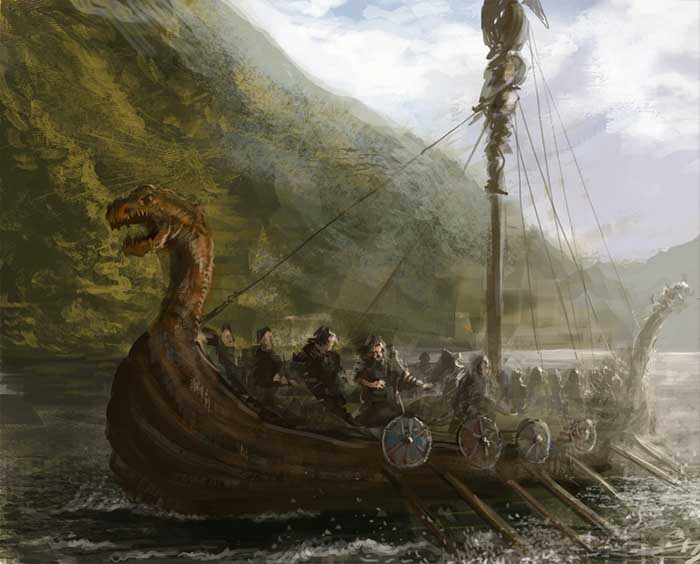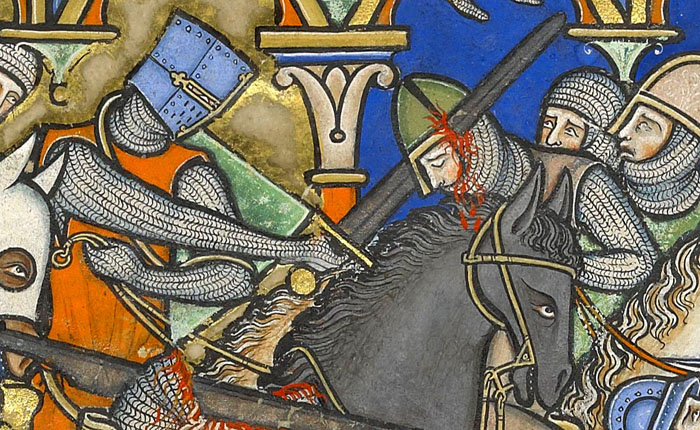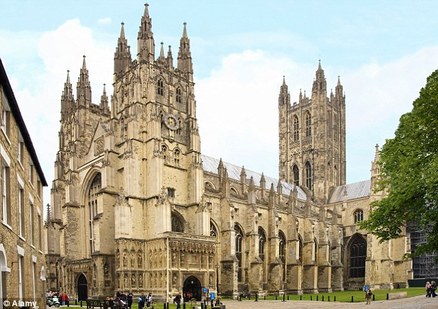Genre-ally Speaking…. (sorry)
Of course, there was no such thing as music genres in the eleventh and twelfth centuries, right?

If you think people did nothing else but stand around singing, and that there weren’t different styles of music, even back then,

Gregorian Chant
One of the earliest and simplest forms of music, Gregorian Chant (named after Pope Gregory I, even if historical evidence seems to suggest this to be a fallacy) featured nothing more than simple, monophonic singing by monks, created as it was for and by the Roman Catholic Church. Performed in Latin, or sometimes Greek, basically you’re talking hymns of praise here, aren’t you? The kind of thing you could only hear in churches and monasteries, as detailed at the beginning of this piece. Usually ensemble works for the mass, therefore liturgical (though not always, but always sacred) they were performed by choirs, usually of men and boys, sometimes men and women. Singing hymns, of course, goes right back to the time of Christ, and is mentioned many times, including when Jesus gathers his followers and Caiphas growls at the crowd to be silent, Jesus says if every tongue were silent the rocks and stones would cry out (or is that from Jesus Christ Superstar?) and hymns are sung at the Last Supper, to name but a few examples.
One assumes, too, that the likes of the Romans and the Greeks had their songs, the former more likely marching songs, songs of battle, and the latter probably in praise of their gods and poetry and the like, but that’s all by the by. People have been singing since they first appeared on this earth, probably. In terms of liturgical, organised music though, it seems Gregorian Chant was the first proper system, and though its practice has died out today (not surprising, given a) how few people attend church these days b) how the Church wants to be seen as more relevant, less rooted in the past and c) how few people understand Latin) it’s still occasionally used, and was even, as I briefly mentioned, and will again, revived in the last century by the rather unexpected channel of pop music.
[youtube]Dlr90NLDp-0[/youtube]
Being the “music of the Church” or the “divine sound of God”, Gregorian Chant was used as a propaganda tool by, among others, the Holy Roman Emperor Charlemagne, who ordered its dissemination across Europe in order to tighten the Church’s hold on power, this order carrying with it the sentence of death for disobedience. The sanctioned chant then spread further, to Scandinavia and into eastern Europe, until by the twelfth and thirteenth century it was the official and only chant in town. As the first “proper” - or one might even say, I suppose, popular - music, Gregorian Chant was also responsible for the beginnings of music notation, much of this being again down to our good friend Guido d’Arezzo; note heads that were flat and square became more rounded and the use of a staff to “hold” the music came into practise.
The shock of 1994 was when an album of Gregorian Chant (entitled, with typical self-effacement and humility, Chant) by the Benedictine Monks of Santo Domingo de Silos reached number three in the pop charts. Nobody knows why, though I suppose it could be the yearning to return to a simpler time, like staring out at the birds in a tree in your garden after spending hours arguing with your friends about which celebrity is doing what, or working on a book, or watching TV. Of course, it didn’t last, and was the most passing of fads, but it does show that, for a time, this music could still be popular - and in a secular way - almost eight hundred years after its heyday.
Ars Nova
We’ve already come across this, both in the timeline, where this new musical form gives its name to an entire era of music, and in the writings of, among others, Johannes de Muris and Phillippe de Vitry, and ars nova (new art) was essentially a move away from the monophonic compositions of Gregorian chant and other plainchant into a magical world of polyphony and new rhythms, which must at the time have seemed very exciting. It should of course be pointed out (and if I don’t someone will no doubt bring it up) that there was polyphonic music before ars nova, in the period known as ars antigua, covering the period approximately from 1170 to 1320, but the ars nova movement seems to have developed in the fourteenth century and to have moved the whole idea forward in leaps and bounds.
New rhythms, the polyphonic compositional techniques previously only available to sacred music now being applied to secular music, new notation: an exciting time for musicians, I’m sure - music became more expressive, more varied, more interesting. Let’s see who the movers and shakers were.
Phillippe de Vitry we have already covered, so our next composer is
Jehan de Lescurel (unknown, fl. 14th century)
As per usual, not exactly three volumes of information on this guy. In fact, the most interesting fact I can find about him is that it was once believed he was hanged for, ahem, crimes against women. Given that his name was quite common at that time though, it’s generally accepted this was an oopsie and that it was some other Jehan de Lescurel who danced in the air at the end of a rope. That’s good then. Other than that, he was a Frenchman, probably studied at Notre Dame and only seems to have got into the new music of polyphony later on, with most of his work monophonic. Yeah.
Guillaume de Machaut (1300-1377 approx)
One thing I tend to do now when researching these guys is look to the right of the Wiki page. If there’s a decent length of scroll, I know there’s stuff to write about him. A short scroll means a few lines and that’s your lot. This one has a pretty long scroll so that’s good. Also, we have dates for his birth (approximate anyway) and death, which makes it easier to talk about him as an actual person who lived, and not just a charcoal line sketch.
Turns out he’s a big cheese in ars nova; phrases used include “immensely influential”, “most significant composer whose name is known” and “the most important poet and composer of the fourteenth century.” He even seems to have had an influence on Chaucer. It says here. Like Guido, our man Guillaume seems to have been named for the region from which he came, Machaut, which makes me wonder if this was standard practice in Medieval times? Could surely get a bit confusing, no? What it you had twenty Guillaumes, all born in the same area? Would they all be called Guillaume de Machaut? Or would parents advise each other when they had a Guillaume, so that they didn’t name their kid the same? More than likely though, it’s that he had a real name, lost to history, and this is just a handy way of identifying him.
[MEDIA=youtube]8Z8rt3hHUEY[/MEDIA]
Surviving through the Black Death, the Bubonic Plague that ravaged Medieval Europe in the fourteenth century and later, de Machaut composed the first complete setting of the Mass, but his secular works always seem to have been on the theme of courtly love - the only other form allowed by the times. This was chaste love, proper love, worshipping from afar and with great respect for the lady. In other words, no “you ma biatch” or any of that sort of thing. Presumably. He also wrote about 400 poems (these not intended for musical performance), many of which used allegory and dreams. He wrote a poetic chronicle of Peter I of Cyprus, which would often be read out during banquets at that country’s court. There is apocryphal evidence that de Machaut may have met Chaucer when both were taken prisoner at Calais, though this is certainly disputed.
Pierre (?) de Molins (fl. Mid-14th century)
So little is known about this lad that even his first name is a guess, and the entry calls him P. de Molins. Could be Percy for all I know, but they seem to think it was Pierre. Would anyone like to hazard a guess, perhaps even this month’s salary on what nationality he was? Seems he composed only two works, but those are important ones and the most popular of the fourteenth century. Does that make him the first rock star of the Middle Ages? Dunno. The pieces are a ballade (De ce que fol pense (that might translate to “it’s you I’m thinking about”, very Boyband for the time! Or not) and the rondeau Amis, tout de vis (“I see you, friends”?) but as usual we have the “no secure biographical information about him exists”, thanks a lot.
Interesting, some scholars tried to ascribe the rondeau above to our old buddy Guillaume de Machaut, but this has been fiercely shot down, and quite right too, I say, as if I had a scooby-doo what I was talking about, but it sounds authoritative, doesn’t it? Does not this beard make me seem more distinguished? No? As you will then, sir!
Jehann Vaillant (fl. 1360-1390)
Tuning was the name of his game, and he wrote a treatise on it, though some people have claimed he was even in advance of the technique of Machaut. He composed a very popular piece called Par maintes foys which has imitation bird calls in it, possibly (though I couldn’t confirm) the first time such a thing had been attempted in music.
Grimace (fl. Mid to late 14th century)
Here we go again! Virtually nothing is known about his life save speculation yadda yadda yadda. Hell, they can’t even say for sure if he was French! Three of his works are contained in the Chantilly Codex, which is mentioned in the section before this, and surely he must have the funniest name, even for a Frenchman, in the Middle Ages. Wonder if there was anyone in that time with the name Smile or Frown? Hah. Enough levity. This is serious stuff. Maybe.
The similarity in his work to that of de Machaut seems to put them in the same sphere, though whether or not they ever met is not mentioned - how many Frenchmen can have been wandering around mid-fourteenth-century France, composing, writing, notating and generally creating musical forms while failing to bump into each other? Weird. Then again, the French are not exactly noted for their friendliness now are they? Probably just ignored each other.
[MEDIA=youtube]QGxORHffVvg[/MEDIA]
I have this scene in my head, of two of these composers, both walking heads down, working on their material and colliding in the street. Conversation then goes thus:
Composer 1: “God bless you, pray have a care where you tread, sir! Cannot you see I am working on an important motet?”
Composer 2: “Hah! Peace be upon you, sir! Ah! Monophonic I see! Have you not woken up to the new polyphonic music yet, grandad?”
Composer 1: “You kids and your multi-part harmonies! God’s beauty is in single notes, sir! Single notes!”
Composer 2: “Were you not so old, I feel I would fain thrash you, sir, for such ignorance!”
Composer 1: “Oh indeed? You and what papal army, pray?”
etc.
But to return to serious subjects, In both of Grimace’s four part works, A l’arme A l’arme and Des que buisson, each upper part shares a contrapuntal relationship with the tenor yeah you don’t care about that and neither do I. There’s certainly a lot of technical waffle on those pages; you could go blind just reading it. We have birdsong again cropping up (and let’s be honest here, birds were the original singers oh no wait, they didn’t come along till after the dinosaurs. But was that before or after we hopped up onto the scene to mess everything up? Which came first, the chicken or the human?) in one of Grimlock, sorry Grimace’s works, Des que buisson and as that’s meant to represent Spring arriving, it makes sense.
Another interesting thing about this possible Frenchman was his usage of battle motifs, particularly in A l’arme A l’arme (I assume that’s Army to Army?) where he uses battlecries and fanfares to represent war.
Francoise Andrieu (fl. Late 14th century)
No guarantee the guy’s first name was Francoise, as he’s usually just called F. Andrieu, but seemingly at least confirmed to be a Frenchman this time, there’s only one of his works left extant, but it is important, as it commemorates the passing of the man seen as the father of this whole style of music and indeed the era to which it gave its name, the G-Man, Guillaume de Machaut, and is seen to be the first example of a composer writing a tribute to another dead composer.
And once again the section begins with those annoyingly familiar words “nothing is known for certain about…” Gahhhh! The elegy he composed, Armes amours, was however based on a text by another pupil of de Machaut, Eustache Deschamps, which I just wanted to mention because it sounds like this guy should definitely have had a moustache, and if he didn’t I’ll be real disappointed. What a cool nickname it would have been after all - Eustache “Moustache” Deschamps. Chortle. Seems there were over 1,500 lyrics in the poem (not entirely sure what constitutes a lyric in these terms, but it seems a lot) so if poor old G-Man had not already been dead, then sitting through that might well have finished him off anyway. Oh wait! I see now he was only “likely” French, so no confirmation, despite the opening lines. Well was he or wasn’t he? We’ll never know. Or care.
Incidentally, if anyone is wondering why I’m being so flippant, it’s because a) much of this stuff is tres boring and b) I find in general enthusiasts of classical music can tend to take themselves and it too seriously, the old stick-up-the-arse attitude, and I don’t hold with that. Well, I wouldn’t hold any stick once it’s been up someone’s ahhh where was I? Oh yeah. It can get really stuffy and formal, with far too much over-reverential praise for composers, and while of course they deserve the praise, it’s good I feel to also lighten the mood and poke gentle fun from time to time, and it makes it easier to read through all this, frankly, sterile and mind-numbingly tedious data in order to decide what to actually use, and how to use it.
If you think I’m being irreverent, I am, but not to give offence. I just have a weird sense of humour, and if you don’t like it, if you’re insulted by it or feel I’m not taking this seriously, let me tell you: research like this can fry your eyeballs and deaden your soul, so I take my fun where I can. There is, after all, no harm in it that I can see, and I’m not exactly worried about the families of guys dead nearly a thousand years coming after me, but if it offends you then maybe this is not the thread for you.











